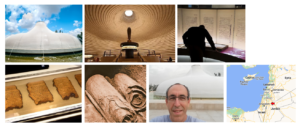There are some places in the world that stand apart from local politics: Bagan in Myanmar (Wow Place #9), the Great Wall of China, the Hermitage Museum in St. Petersburg, Russia, etc. Whatever you may think of the governments of the host countries, the sights, themselves, remains eternal. Once other such site is the Dead Sea Scrolls in Jerusalem.
Adjoining the Israel Museum, the “Shrine of the Book” houses one of the most important ancient manuscripts the world has ever seen. Discovered between 1947 and 1956 in eleven caves near the Khirbet Qumran on the northwestern shores of the Dead Sea, the Scrolls are a remarkable find. Dating from the third century BCE to the first century CE, the Scrolls were written mostly in Hebrew, with a smaller number in Aramaic and Greek. Most were scrawled out on parchment, with a few written on papyrus. The vast majority of the Scrolls survive as fragments. Nevertheless, scholars have reconstructed these fragments with extraordinary success, giving us a tantalizing glimpse into a time long past.

Included in the Scrolls are: the world’s earliest evidence for the biblical text; apocryphal manuscripts that had previously been known only in translation (or not at all); a variety of sectarian texts comprising biblical commentary, religious-legal writings, liturgical texts and apocalyptic compositions. Thanks to the Dead Sea Scrolls, scholars have gained a huge leap in their knowledge of Jewish society during the Hellenistic and Roman periods, as well as the origins of rabbinical Judaism and Christianity.
Visiting the Shrine of the Book is a thrilling experience. The first thing you notice is the shape of the building itself – a white, curved dome built to resemble the lid of the jars in which the Scrolls were originally found. In other words, to visit the Scrolls is to walk inside a giant, ancient jar! Once inside, you travel from an upper gallery to a lower gallery. The upper takes you through the story of the sectarians living at Qumran. The lower tells the story of the Aleppo Codex, the closest text we have to the printed Hebrew Bibles used today.
Imagine going to a library at Oxford or Cambridge. The light is warm and subdued. Scholars quietly peruse ancient texts in glass cases, while gawking visitors dare not to speak, such is the hushed atmosphere of the environment. That’s what it’s like in the Shrine of the Book. And all the while, you’re pretty much standing inside of a giant, ancient jar, as if you, too, have been entombed along with the Scrolls. It’s a weird, disconcerting feeling and totally unique, just like the Dead Sea Scrolls themselves.
(If you travel enough, you’ll inevitably ask yourself, “Do I really want to go there?” It may be because you don’t agree with the government. Or perhaps you don’t like the artist who created the work in question. For example, do you watch a movie by Roman Polansky or Woody Allen, when questions swirl around their personal lives? Do you listen to the works of Richard Wagner, an alleged anti-Semite? These are difficult questions, difficult choices — with no easy answers. About all you can do is check in with your ethics and morals and decide if the sight, location or piece of art can possibly stand on its own, independent of its complicated background. That’s life on the planet, I guess – facing difficult, moral questions and learning about yourself along the way.)
